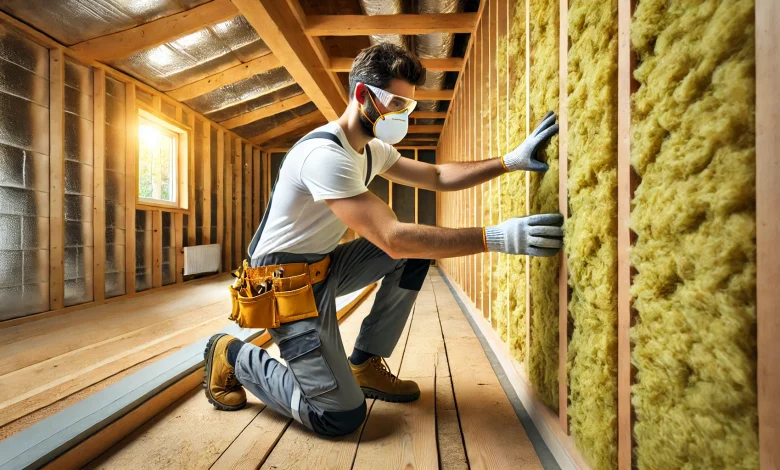Internal Wall Insulation: Everything You Need to Know

When it comes to making your home more energy-efficient, one of the most effective strategies is to focus on internal wall insulation. Whether you’re trying to reduce energy bills, keep your home warmer in the winter, or make your space more comfortable year-round, internal wall insulation offers a range of benefits. In this article, we’ll dive deep into what internal wall insulation is, its advantages, the different types available, how it’s installed, and whether it’s worth the investment for your home.
What Is Internal Wall Insulation?
Internal wall insulation (IWI) is a technique used to reduce heat loss from the walls of a building. Unlike external wall insulation, which is applied to the exterior of a building, internal wall insulation involves installing insulating materials directly onto the inner surfaces of your walls. This method is especially effective in older properties that have solid walls rather than modern cavity walls.
The primary function of internal wall insulation is to keep the warmth inside during the colder months and reduce energy consumption, making your home more energy-efficient. However, it also helps maintain a more consistent indoor temperature, which is beneficial for comfort throughout the year.
Why Choose Internal Wall Insulation?
There are several reasons why homeowners opt for internal wall insulation. One of the most compelling reasons is energy efficiency. Without proper insulation, up to 45% of the heat inside your home can escape through the walls. By installing internal wall insulation, you can dramatically reduce this heat loss, leading to lower heating costs and a more comfortable living space.
Another reason is that internal wall insulation is often a more practical choice than external wall insulation in certain circumstances. If you live in a property with limited space or if the exterior of your building cannot be altered for aesthetic or practical reasons (such as a listed building), internal wall insulation may be your best bet.
Additionally, internal wall insulation can enhance the overall thermal comfort of your home. It can help prevent cold spots on walls, reduce condensation and the potential for damp, and create a more stable indoor environment. For people who suffer from allergies, controlling moisture and reducing mold growth can also have health benefits.
The Different Types of Internal Wall Insulation

When it comes to choosing the right type of Internal Wall Insulation, there are several options available. Let’s take a look at the most common materials used for internal wall insulation.
1. Insulating Plasterboard
One of the most popular choices for internal wall insulation is insulating plasterboard. This material consists of a layer of insulation attached to a plasterboard sheet, providing both insulation and a finished wall surface. It’s relatively easy to install and can be applied directly to the existing wall.
Plasterboard is versatile and can be used in a variety of settings, from homes to commercial buildings. It also allows you to finish the wall in any way you desire—whether that means painting it, wallpapering it, or leaving it as is for a smooth, minimalist look.
2. Polyurethane Foam
Polyurethane foam is another highly effective insulating material. It’s commonly sprayed directly onto the wall surfaces and expands to fill gaps and cracks, providing a seamless barrier against heat loss. Polyurethane foam is known for its excellent thermal performance, making it a great choice for homeowners looking to maximize energy efficiency.
Although it’s effective, polyurethane foam can be more expensive than some other options, and the installation process requires professional expertise. Additionally, it may not be ideal for all types of walls, especially those that are prone to moisture or humidity.
3. Mineral Wool or Rock Wool Insulation
Mineral wool, also known as rock wool, is a popular choice for internal wall insulation due to its excellent soundproofing qualities. It’s made from natural or recycled materials, including basalt or diabase rock, and offers good thermal performance.
The primary advantage of mineral wool insulation is its fire resistance and the ability to withstand high temperatures. It’s also an environmentally friendly option, making it a great choice for those who are conscious of their ecological footprint.
How Is Internal Wall Insulation Installed?
Installing internal wall insulation is a job that typically requires the expertise of a professional, as it involves more than just slapping a sheet of insulation on the wall. The process begins with assessing the condition of the existing walls and determining the best insulation material for the job.
1. Preparation
Before installation begins, any fixtures or fittings on the walls must be removed. This includes electrical outlets, light switches, or any built-in furniture. The walls will also need to be cleaned and any damp or mold issues addressed before proceeding.
2. Fitting the Insulation
The insulation material is then fixed directly to the walls. In the case of plasterboard insulation, the sheets are typically mounted using adhesive or mechanical fixings. Other materials like mineral wool or foam may be installed in layers or sprayed directly onto the surface.
3. Finishing the Wall
Once the insulation is securely in place, the walls are finished. For plasterboard installations, this could mean taping, plastering, or applying a skim coat of plaster to smooth out any seams. Once the wall is dry, you can repaint or wallpaper to match your existing decor.
The entire process can take several days depending on the size of the area being insulated, and homeowners can expect some disruption during the installation process.
Benefits of Internal Wall Insulation
There are several key benefits to installing internal wall insulation in your home. Here are just a few of the most compelling reasons to consider this energy-saving upgrade.
1. Improved Energy Efficiency
As mentioned earlier, the primary reason for installing internal wall insulation is to improve your home’s energy efficiency. By reducing heat loss, your heating system doesn’t have to work as hard to maintain a comfortable temperature. This leads to significant energy savings and lower utility bills.
2. Enhanced Comfort
A well-insulated home feels more comfortable year-round. In the winter, internal wall insulation keeps the heat inside, while in the summer, it helps prevent excessive heat from entering. This creates a more stable indoor temperature and can even help reduce the need for air conditioning in the warmer months.
3. Soundproofing
Internal wall insulation is also effective in reducing sound transmission between rooms. Whether you’re living in a shared apartment building or simply want more peace and quiet in your home, insulating your walls can help to minimize noise from the outside or other rooms.
4. Increased Property Value
Homes that are more energy-efficient tend to be more attractive to buyers. If you decide to sell your home in the future, having internal wall insulation could increase its market value by improving both its energy efficiency and comfort levels.
Is Internal Wall Insulation Worth the Investment?
Now, the question arises: Is internal wall insulation worth it? The answer depends on several factors, including the age of your home, your budget, and your long-term energy savings goals.
For older homes with solid brick or stone walls, internal wall insulation is often the most practical option, as external insulation may not be feasible due to space limitations or aesthetic concerns. However, if you live in a modern home with cavity walls, you might want to consider external insulation or cavity wall insulation instead.
Additionally, the upfront cost of internal wall insulation can be significant, especially if you choose high-end materials or professional installation. However, the long-term energy savings can make it a worthwhile investment. The savings on your heating and cooling bills could help pay for the installation within a few years, after which you’ll continue to benefit from lower energy costs.
Conclusion
Internal wall insulation is a smart way to enhance the energy efficiency and comfort of your home. It offers a range of benefits, from improved thermal performance to better soundproofing and reduced energy costs. While the installation process may require a bit of an investment upfront, the long-term savings and comfort improvements make it a worthwhile consideration for many homeowners.
If you’re ready to take the plunge into better insulation, make sure to consult with a professional to determine the best insulation material and installation method for your home. With the right choice, you can enjoy a warmer, quieter, and more energy-efficient living space for years to come.



